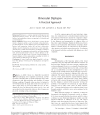

Confusion develops when two different objects are imaged on corresponding retinal areas and perceived concurrently by the brain. Binocular triplopia exists when the fovea of one eye localizes one visual object simultaneously in two visual directions while viewing the object with both eyes at the same time. It usually resolves within days to weeks. Paradoxical diplopia takes place in the presence of persistent anomalous retinal correspondence after strabismus surgery.

Physiologic diplopia is a normal response to binocular vision and serves as evidence of normal cooperation of the two eyes. Monocular diplopia may occur from anomalies of the ocular media, in the presence of optical aberrations, due to cortical dysfunction, or due to sensory anomalies. Binocular diplopia is a normal, physiologically correct response and happens when identical objects are imaged on disparate retinal areas. Suppression is strictly limited to binocular vision, an adaptation to avoid diplopia and confusion. Motor fusion is the ability to align the eyes so that sensory fusion is maintained. Sensory fusion refers to binocular single vision. Peripheral fusion occurs in response to images falling on corresponding retinal areas within the extrafoveal retinal periphery. Central fusion results when an image falls on corresponding retinal points within the fovea. Anomalous retinal correspondence occurs to restore crude binocularity when the eyes are not able to work together via sensory and motor fusion. Individuals with normal retinal correspondence and aligned eyes have single vision. Several requirements are necessary for single visual images.


 0 kommentar(er)
0 kommentar(er)
